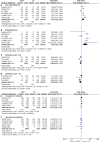Early goal-directed and lactate-guided therapy in adult patients with severe sepsis and septic shock: a meta-analysis of randomized controlled trials
- PMID: 30486885
- PMCID: PMC6264603
- DOI: 10.1186/s12967-018-1700-7
Early goal-directed and lactate-guided therapy in adult patients with severe sepsis and septic shock: a meta-analysis of randomized controlled trials
Abstract
Background: The ProCESS, ARISE, and ProMISe trials have failed to show that early goal-directed therapy (EGDT) reduces mortality in patients with severe sepsis and septic shock. Although lactate-guided therapy (LGT) has been shown to result in significantly lower mortality, its use remains controversial. Therefore, we performed a meta-analysis to evaluate EGDT vs. LGT or usual care (UC) in adult patients with severe sepsis and septic shock.
Methods: Relevant randomized controlled trials published from January 1, 2001 to March 30, 2017 were identified in PubMed, EMBASE, Web of Science, and the Cochrane Library. The primary outcome was mortality; secondary outcomes included red cell transfusions, dobutamine use, vasopressor infusion, and mechanical ventilation support within the first 6 h and Acute Physiology and Chronic Health Evaluation II (APACHE II) score.
Results: Sixteen studies enrolling 5968 patients with 2956 in EGDT, 2547 in UC, and 465 in LGT were included in this meta-analysis. Compared with UC, EGDT was associated with a lower mortality (10 trials; RR 0.85, 95% CI 0.74-0.97, P = 0.01), and this difference was more pronounced in the subgroup of UC patients with mortality > 30%. In addition, EGDT patients received more red cell transfusions, dobutamine, and vasopressor infusions within the first 6 h. Compared with LGT, EGDT was associated with higher mortality (6 trials; RR 1.42, 95% CI 1.19-1.70, P = 0.0001) with no heterogeneity (P = 0.727, I2 = 0%).
Conclusion: EGDT seems to reduce mortality in adult patients with severe sepsis and septic shock, and the benefit may primarily be attributed to red cell transfusions, dobutamine administration, and vasopressor infusions within the first 6 h. However, LGT may result in a greater mortality benefit than EGDT.
Keywords: EGDT; Lactate-guided therapy; Meta-analysis; Sepsis; Usual care.
Figures







Comment in
-
Standard of usual care defines effectiveness of early goal directed therapy.Ann Transl Med. 2019 Dec;7(Suppl 8):S352. doi: 10.21037/atm.2019.09.71. Ann Transl Med. 2019. PMID: 32016070 Free PMC article. No abstract available.
Similar articles
-
Early Goal-Directed Therapy in Severe Sepsis and Septic Shock: A Meta-Analysis and Trial Sequential Analysis of Randomized Controlled Trials.J Intensive Care Med. 2018 May;33(5):296-309. doi: 10.1177/0885066616671710. Epub 2016 Oct 22. J Intensive Care Med. 2018. PMID: 27756870
-
Early goal-directed therapy in the management of severe sepsis or septic shock in adults: a meta-analysis of randomized controlled trials.BMC Med. 2015 Apr 3;13:71. doi: 10.1186/s12916-015-0312-9. BMC Med. 2015. PMID: 25885654 Free PMC article.
-
The effect of early goal-directed therapy on mortality in patients with severe sepsis and septic shock: a meta-analysis.J Surg Res. 2016 May 15;202(2):389-97. doi: 10.1016/j.jss.2015.12.048. Epub 2016 Jan 4. J Surg Res. 2016. PMID: 27229114
-
Early goal-directed resuscitation for patients with severe sepsis and septic shock: a meta-analysis and trial sequential analysis.Scand J Trauma Resusc Emerg Med. 2016 Mar 5;24:23. doi: 10.1186/s13049-016-0214-7. Scand J Trauma Resusc Emerg Med. 2016. PMID: 26946514 Free PMC article.
-
Early goal-directed therapy reduces mortality in adult patients with severe sepsis and septic shock: Systematic review and meta-analysis.Indian J Crit Care Med. 2015 Jul;19(7):401-11. doi: 10.4103/0972-5229.160281. Indian J Crit Care Med. 2015. PMID: 26180433 Free PMC article. Review.
Cited by
-
Predicting 30-days mortality for MIMIC-III patients with sepsis-3: a machine learning approach using XGboost.J Transl Med. 2020 Dec 7;18(1):462. doi: 10.1186/s12967-020-02620-5. J Transl Med. 2020. PMID: 33287854 Free PMC article.
-
Value of using blood routine indicators combined with artificial intelligence in sepsis patients.Am J Transl Res. 2025 Apr 15;17(4):2678-2689. doi: 10.62347/MMNQ1017. eCollection 2025. Am J Transl Res. 2025. PMID: 40385034 Free PMC article.
-
[The ROSE concept: modern fluid management in intensive care medicine].Med Klin Intensivmed Notfmed. 2024 Nov;119(8):634-639. doi: 10.1007/s00063-024-01193-1. Epub 2024 Oct 9. Med Klin Intensivmed Notfmed. 2024. PMID: 39382684 German.
-
Association Between Lactate and 28-Day Mortality in Elderly Patients with Sepsis: Results from MIMIC-IV Database.Infect Dis Ther. 2023 Feb;12(2):459-472. doi: 10.1007/s40121-022-00736-3. Epub 2022 Dec 15. Infect Dis Ther. 2023. PMID: 36520327 Free PMC article.
-
Septic Shock: Phenotypes and Outcomes.Adv Ther. 2022 Nov;39(11):5058-5071. doi: 10.1007/s12325-022-02280-5. Epub 2022 Sep 1. Adv Ther. 2022. PMID: 36050614
References
-
- Torio CM, Andrews RM. Healthcare Cost and Utilization Project (HCUP) Statistical Briefs. Rockville: Agency for Healthcare Research and Quality; 2006. National inpatient hospital costs: the most expensive conditions by payer 2007: statistical Brief#160[A] - PubMed
Publication types
MeSH terms
Substances
Grants and funding
- 81370364/the National Natural Science Foundation of China/International
- 16IRTSTHN021/the Science and Technology Innovation Team at the Universities of Henan province/International
- 2016-32/the "51282" Project Leaders of Scientific and Technological Innovative Talents from Health and Family Planning Commission in Henan Province/International
LinkOut - more resources
Full Text Sources

